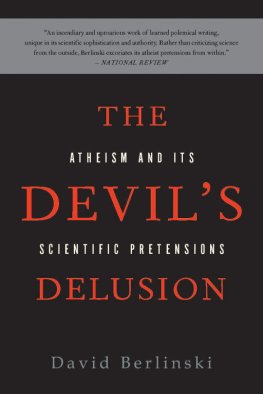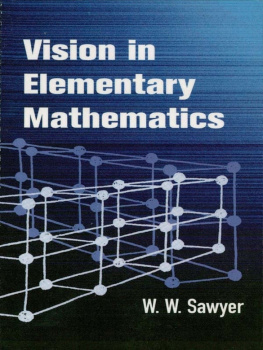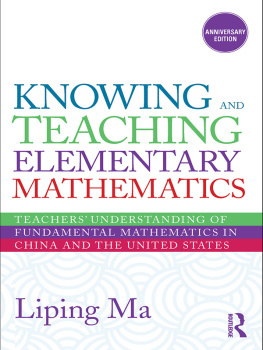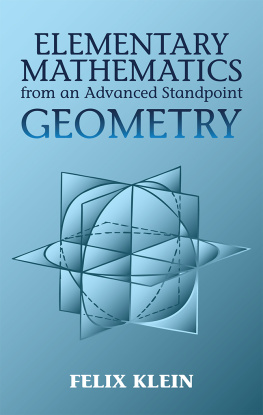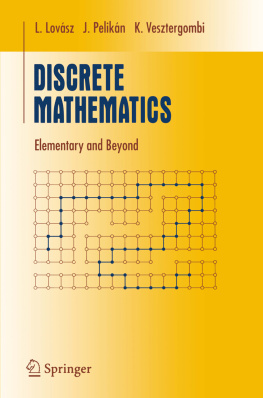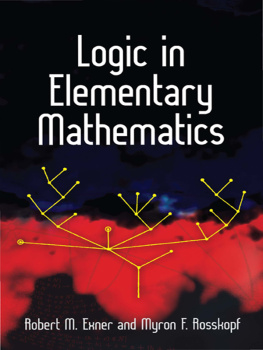David Berlinski - One, Two, Three: Absolutely Elementary Mathematics
Here you can read online David Berlinski - One, Two, Three: Absolutely Elementary Mathematics full text of the book (entire story) in english for free. Download pdf and epub, get meaning, cover and reviews about this ebook. year: 2011, publisher: Pantheon, genre: Religion. Description of the work, (preface) as well as reviews are available. Best literature library LitArk.com created for fans of good reading and offers a wide selection of genres:
Romance novel
Science fiction
Adventure
Detective
Science
History
Home and family
Prose
Art
Politics
Computer
Non-fiction
Religion
Business
Children
Humor
Choose a favorite category and find really read worthwhile books. Enjoy immersion in the world of imagination, feel the emotions of the characters or learn something new for yourself, make an fascinating discovery.

- Book:One, Two, Three: Absolutely Elementary Mathematics
- Author:
- Publisher:Pantheon
- Genre:
- Year:2011
- Rating:5 / 5
- Favourites:Add to favourites
- Your mark:
- 100
- 1
- 2
- 3
- 4
- 5
One, Two, Three: Absolutely Elementary Mathematics: summary, description and annotation
We offer to read an annotation, description, summary or preface (depends on what the author of the book "One, Two, Three: Absolutely Elementary Mathematics" wrote himself). If you haven't found the necessary information about the book — write in the comments, we will try to find it.
One, Two, Three: Absolutely Elementary Mathematics — read online for free the complete book (whole text) full work
Below is the text of the book, divided by pages. System saving the place of the last page read, allows you to conveniently read the book "One, Two, Three: Absolutely Elementary Mathematics" online for free, without having to search again every time where you left off. Put a bookmark, and you can go to the page where you finished reading at any time.
Font size:
Interval:
Bookmark:
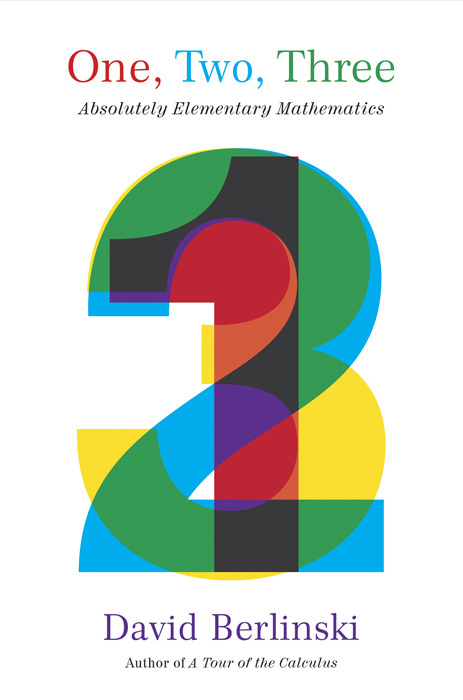
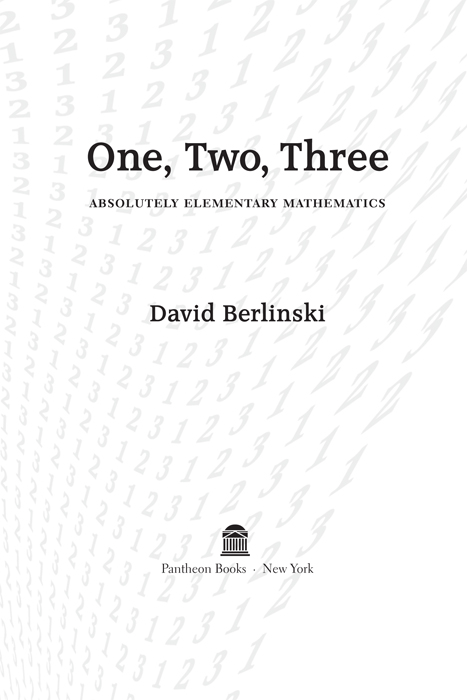
Copyright 2011 by David Berlinski
All rights reserved. Published in the United States by Pantheon Books,
a division of Random House, Inc., New York, and in Canada by
Random House of Canada Limited, Toronto.
Pantheon Books and colophon are
registered trademarks of Random House, Inc.
Harem Scene with Sultan, by Jean-Baptiste van Mour, reproduced
courtesy of Azize Taylan and with the assistance of Okan Altiparmak.
Library of Congress Cataloging-in-Publication Data
Berlinski, David, [date]
One, two, three : absolutely elementary mathematics / David Berlinski.
p. cm.
Includes index.
eISBN: 978-0-307-37985-6
1. Symmetry (Mathematics) I. Title.
QA174.7.S96B47 2011 510dc22 2010038555
www.pantheonbooks.com
Jacket design by Brian Barth
v3.1
For Neal Kozodoy
We read to find out what we already know.
V. S. Naipaul
This is a little book about absolutely elementary mathematics (AEM); and so a book about the natural numbers, zero, the negative numbers, and the fractions. It is neither a textbook, a treatise, nor a trot. I should like to think that this book acts as an anchor to my other books about mathematics.
Mathematicians have always imagined that mathematics is rather like a city, one whose skyline is dominated by three great towers, the state ministries of a powerful intellectual cultureour own, as it happens. They are, these great buildings, devoted to Geometry, Analysis, and Algebra: the study of space, the study of time, and the study of symbols and structures.
Imposing as Babylonian ziggurats, these buildings convey a sacred air.
The common ground on which they rest is sacred too, made sacred by the scuffle of human feet.
This is the domain of absolutely elementary mathematics.
Many parts of mathematics glitter alluringly. They are exotic. Elementary mathematics, on the other hand, evokes the very stuff of life: paying bills, marking birthdays, dividing debts, cutting bread, and measuring distances. It is earthy. Were textbooks to disappear tomorrow, and with them the treasures that they contain, it would take centuries to rediscover the calculus, but only days to recover our debts, and with our debts, the numbers that express them.
Elementary mathematics as it is often taught and sometimes used requires an immersion into messiness. Patience is demanded, pleasure deferred. Decimal points seem to wander, negative numbers become positive, and fractions stand suddenly on their heads.
And what is three-fourths divided by seven-eights?
The electronic calculator has allowed almost everyone to treat questions such as this with an insouciant indifference. Quick, accurate, and cheap, it does better what one hundred years ago men and women struggled to do well. The sense that in elementary mathematics things are familiarhalf remembered, even if half forgottenis comforting, and so are the calculator and the computer, faithful almost to a fault, but the imperatives of memory and technology do prompt an obvious question: why bother to learn what we already know or at least thought we knew?
The question embodies a confusion. The techniques of elementary mathematics are one thing, but their explanations are quite another. Everyone can add two simple natural numbers togethertwo and two, for instance. It is much harder to say what addition means and why it is justified. Mathematics explains the meaning and provides the justification. The theories that result demand the same combination of art and sophistication that is characteristic of any great intellectual endeavor.
It could so easily have been otherwise. Elementary mathematics, although pressing in its urgency, might have refused to cohere in its theory, so that, when laid out, it resembled a map in which roads diverged for no good reason or ended in a hopeless jumble. But the theory by which elementary mathematics is explained and its techniques are justified is intellectually coherent. It is powerful. It makes sense. It is never counter-intuitive. And so it is appropriate to its subject. If when it comes to the simplest of mathematical operationsaddition againthere remains something that we do not understand, that is only because there is nothing in nature (or in life) that we understand as completely as we might wish.
Nonetheless, the theory that results is radical. Do not doubt it. The staples of childhood education are gone in the night. One idea is left, and so one idea predominates: that the calculations and concepts of absolutely elementary mathematics are controlled by the single act of counting by one. There is in this analysis an economy of effect, and a reduction of experience to its essentials, as dramatic as anything found in the physical sciences.
Until the end of the nineteenth century, this was not understood. A century later, it is still not widely understood. School instruction is of little help. Please forget what you have learned in school, the German mathematician Edmund Landau wrote in his book Foundations of Analysis; you havent learned it.
From time to time, I am going to ask that readers do some forgetting all their own.
A secret must now be imparted. It is one familiar to anyone writing about (or teaching) mathematics: no one very much likes the subject. It is best to say this at once. Like chess, mathematics has the power to command obsession but not often affection.
Why should this bethe distaste for mathematics, I mean?
There are two obvious reasons. Mathematics confronts the beginner with an aura of strangeness, one roughly in proportion to its use of arcane symbols. There is something about mathematical symbolism, a kind of peevishness, that while it demands patience, seems hardly to promise pleasure.
Why bother?
If the symbolic apparatus of mathematics is one impediment to its appreciation, the arguments that it makes are another. Mathematics is a matter of proof, or it is nothing. But certainty does not come cheap. There is often a remarkable level of detail in even a simple mathematical argument, and, what is worse, a maddening difference between the complicated structure of a proof and the simple and obvious thing it is intended to demonstrate. There is no natural number standing between zero and one. Who would doubt it? Yet it must be shown, and shown step by step. Difficult ideas are required.
Why bother?
A tricky bargain is inevitably involved. In mathematics, something must be invested before anything is gained, and what is gained is never quite so palpable as what has been invested. It is a bargain that many men and women reject.
Why bother indeed?
The question is not ignominious. It merits an answer.
In the case of many parts of mathematics, answers are obvious. Geometry is the study of space, the mysterious stuff between points. To be indifferent to geometry is to be indifferent to the physical world. This is one reason that high-school students have traditionally accepted Euclid with the grudging sense that they were being forced to learn something that they needed to know.
And algebra? The repugnance (in high school) that this subject evokes has always been balanced by the sense that its symbols have a magical power to control the flux and fleen of things. Farmers and fertilizers were the staple of ancient textbooks. But energy and mass figure in those that are modern. Einstein required
Font size:
Interval:
Bookmark:
Similar books «One, Two, Three: Absolutely Elementary Mathematics»
Look at similar books to One, Two, Three: Absolutely Elementary Mathematics. We have selected literature similar in name and meaning in the hope of providing readers with more options to find new, interesting, not yet read works.
Discussion, reviews of the book One, Two, Three: Absolutely Elementary Mathematics and just readers' own opinions. Leave your comments, write what you think about the work, its meaning or the main characters. Specify what exactly you liked and what you didn't like, and why you think so.

